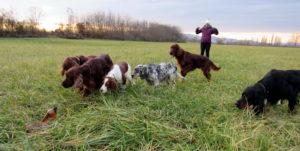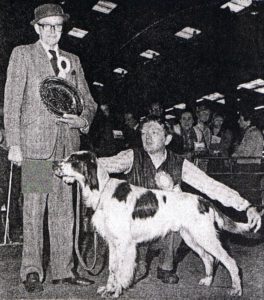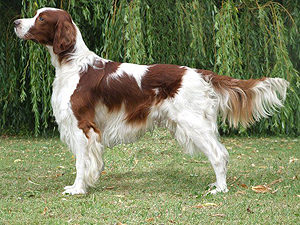The Irish Red AND WHITE setter
Beyond the three known setter breed (the English, the Gordon and the Irish setter) exists a fourth one, the irish red and white setter, which was until recently unknown in Hungary and today is still very rare.

The history of the setter can be traced back for several centuries. He was known in England & Ireland long before the Pointer, but was preceded by the Spaniel, and there is little doubt that from the different varieties of Spaniel, the various setter families evolved. Dr. Caius, in 1570, writing about dogs used for sport, says “The common sort of people call them by one general word, namely “Spaniels”, and in speaking of colour, says: “The most part of their skins are white, and if they are marked with any spots they are commonly red, and somewhat great”. We may therefore assume that the original “setting” dogs were white with big red patches. By the 16th century “setting dogs” were referred to in numerous manuscripts and by the 17th century dogs resembling the Irish Red and White Setter appeared in numerous paintings.

By the mid eighteenth century “setters” had become an essential and prized possession for the sporting country gentleman. The colour of the “setters” varied from almost all red, red with white paws, etc. white with red patches to almost completely white dogs.
In 1863 at the Rotunda Show in Dublin, both colours were exhibited but from this time onwards the “red setter” appears to take over the red and white setter in popularity. The revival of the Irish Red and White Setter begins in the early 1900’s and a number of Irish people were responsible for getting the breed into its current situation.
The revival of the Irish Red and White Setter really begins after the first World War primarily through efforts of the Rev. Noble Houston from Ballinahinch, Co. Down. Rev. Noble Houston (Eldron Prefix) : During the 1914-18 war, he was an army chaplain and when he returned home he found that almost all the good dogs had disappeared. Keeping stock during the war had proved enormously difficult because of the shortage of food and the breeding of dogs for sport had virtually ceased.
The Reverend Houston sought to get started again and in his desire was supported by a Dr Elliot who lived in a house called Eldron, and this name was to become a prefix for many of their dogs. There were still a few dogs in Monaghan and they obtained a bitch called Gyp (later Eldon Gyp) from a gamekeeper. She was mismarked but from a red and white dog from County Cavan and a red bitch. She was mated to Mr Evatt’s Johnnie and later to Glen of Rossmore. From the resulting litters, Mr Houston’s line was built up and provides the link to the Setters of today via Mrs Cuddy’s Knockalla breeding. Some of his better known dogs, such a Unagh, Blanco, Cohan and Bobs of Derryboy are in today’s pedigrees. Bobs was shown on a number of occasions and did very well.
In the early 1940’s the Rev. Houston by this time an elderly man was writing to Mrs Cuddy (then Mrs Clarke) about her interest in the Irish Red and White Setter.


The Irish Red & White Setter Society : In 1944 the Irish Red & White Setter Society was formed the objects of which were:
– To encourage the working qualities of the breed in every possible way.
– To promote the breeding of them upon sound working principles.
– To ensure that if they were classified at shows, they were judged from a working standpoint.
Mrs Cuddy however, continued to breed and kept careful records, which were to prove invaluable, to the establishment of the breed. Mrs Cuddy made a major contribution in keeping the breed going during the 50’s and 60’s. She bred her last litter in 1977 mating her bitch “Gaye of Knockalla” to “Glenkeen Sandy” – a red dog that carried a lot of white. The litter contained. “Harlequin of Knockalla” which went to Ann and Alan Gormley, Hickory of Knockalla (nearly all white) which went to Terry O’Leary, and Hawk of Knockalla (Red with white markings) which went to Sean Walsh.

In 1980 Alan decided to enter Harlequin at Crufts as his Green Star wins in Ireland qualified him for entry – but “Irish Red and White Setters” were unknown in England at this time and he was classed as an “Irish Red Setter” and benched in the middle of them all. I can still remember to this day the attention this dog received and this sparked off my interest and the interest of numerous other people in this country to further the development of the breed.
The British Kennel Club acknowledged it in 1980. The two clubs- the British Irish Red and the White Setter Club- in charge of taking care of the breed, had been established in 1984. Last, the FCI recognized officially this breed in June 1987 during their assembly in Tel Aviv.
Outside Ireland and Great-Britain, in the European continent (primarily in Italy, Germany, Netherlands and Belgium) there are specimens in significant numbers already. In our country, three specimens had arrived in 2002: one male from Italy and one female from Germany (these two are living at the same owner) and at the end of the year an additional male-the first import from England- had arrived. An interesting thing of his pedigree is that Harlequin Knockalla – who promoted the breed in England- can be found on the registry form.
The original task of the breed is of course hunting. Proceeding in front of his owner, scenting from the air, the dog searches for hiding birds (pheasant, partridge). When the dog finds one bird, he takes on a distinctive pose lifting his front leg “stand” the wild animal, while the hunters arrive. They must stay standing, regardless how long it takes for his leader to get there, nothing should be able to distract his attention. Under normal circumstances, it is not the setters task to bring the shot wild animal, but it could be trained for that as well. During Field Trial competitions the setter never has to apport.

In order to perform his tasks, the red-white Irish setter must be athletic and enduring that is capable to work all day long often on difficult terrain. In one of his writings Alan Gormley compares the red Irish setter to the English thoroughbred, the red-white setter on the other hand he compares to a strong hackney with outstanding working capacity.
The Irish Red & White Setter is a healthy breed. Out of the 300+ inherited canine diseases, IRWS have just 3 that we know of after constant monitoring since the 1980s. They are Canine Leucocyte Adhesion Deficiency (CLAD), von Willebrands Disease (vWD) and Posterior Polar Cataract (PPC). The only way to know definitely that a dog does not have the genes for these diseases is by DNA test and breeders ensure that their breeding stock is clear by test or by having clear parents and thus being unable to pass the conditions on. HD (hips dyslexia) which is present in many other breeds, effects the red-white Irish setter less and this condition can be detected and filtered out by X-ray.
The Red-White Irish Setter often performs his task far away from his leader, therefore it is extremely important that he is capable to make independent decisions. For this he needs a rather advanced intelligence. On the other hand, the owner can sometimes experience the downside of high intelligence. If purchased from a suitable environment and reliable breeder, the puppy generally becomes a well-balanced, good natured grown-up dog. It is proven to be a good family dog that gets along well with other animals and it likes kids.

The breeds standard can be compared in a lot of respects to the its closest relative, the red Irish setter. At this time I would like to emphasize only the defining differences. There is a significant discrepancy of the head types of the two breed. While the Red Irish Setters scull is narrower and its occipital is definite, for the red-white a wider, flatter skull and an insignificant occipital is typical. In case of the Red-White Setter the foreface is less squared with minimal lobe at the lip.
The other difference is of course the colour. At first glance, the Red-White Irish Setter appears to be a red dog on white base, but by no means a white spotted on red base. On its body, well-defined, contoured red spots can be found, the middle of its head is divided by a white line, the ears in all cases are red. Dots freckles and the characteristic roan colouring of the English Setter, should only occur on the foreface, the front legs up to the elbow and on the rear legs up to the hock. On the body itself it is considered to be a blemish. A serious fault if the dog wears a coat that is if its entire back, all the way down on its sides and legs are covered with a continuous red patch. These kind of dogs are excluded from breeding. It is important that both colours must be bright and brilliant. The white is not reminiscent of the matt colour of the poodle, rather it must be similar to pearl with a silky gloss. The breed has all the aptness to be popular. The attractive extern is coupled with valuable internal properties. We hope that its Hungarian introduction will be a success, followed by a wider recognition and affection for this breed with excellent endowments: the red and white Irish setter.
Sources:
Setter Friendship Society (2010) (Hun): Irish red and white setter. International Dog Magazin (Hun).
Ács, Piroska (Stirling Bridge Kennel) (2011): Diploma work. Szent István University.
Hungarian Setter and Pointer Club
MEOE Setter Club
standard
FCI standard Nr. 333 (1989)

Origin:
Ireland
Date of publication of the original valid breed standard:
19.04.05
CLASSIFICATION F.C.I
Group 7 Pointing Dogs, Section 2 British and Irish Pointers and setters. With Working Trial.
BRIEF HISTORICAL SUMMARY
The Irish Setter probably came to its own at the end of the 17th century. It is not well known outside of Ireland that there are two breeds of Irish setters, but is fairly certain, that the Red and White Setter is the older of the two. and that judicious selective breeding evolved the solid red colour. When Irish Setters came to the show benches, just past the middle of the 19th century, there was a good deal of confusion about their proper colour. By the end of the 19th century, the Red Setter had virtually eclipsed the Red and White, which became so rare, that they were thought to be extinct. During the 1920s, efforts were made to revive the breed. By 1944, the breed had re-established itself well enough to have a club of its own, and today it can be seen in healthy numbers at Irish shows and Field Trials. The present Club the Irish Red and White Setter Field and Show Society was formed in 1981 and through its endeavours and direction the breed is now well established nationally and internationally. The Irish Red and White Setter competes successfully in Field Trials against the other pointing breeds and there are now quite a number of Field Trial Champions and Show Champions.
GENERAL APPEARANCE
Strong well balanced and proportioned without lumber; athletic rather than racy. The Irish Red and White Setter is bred primarily for the field and must be judged from the working standpoint
BEHAVIOUR/TEMPERAMENT
Aristocratic, keen and intelligent. Displays a kindly, friendly attitude, behind which should be discernible determination, courage and high spirit. The Red and White Setter is very friendly, dependable and easily trained gundog.
HEAD
Broad in proportion to the body
CRANIAL REGION
Skull: Domed without showing occipital protuberance, as in the Irish Setter.
Stop: Good stop
FACIAL REGION
Muzzle: Clean and square
Jaws: Jaws of equal or nearly equal length
Teeth: Regular teeth; scissor bite ideal: edge to edge bite acceptable.
Eyes: Dark hazel or dark brown; oval, with slight prominence and without haw.
Ears: Set level with the eyes, and well back, lying close to the head.
NECK
Moderately long, very muscular, but not too thick, slightly arched, free from all tendency to throatiness
BODY
Strong and muscular
Back: To be strong and well muscled
Chest: Deep with well sprung ribs
TAIL
Moderate length, not reaching below the hock, strong at the root. Tapering to a fine point; no appearance of ropiness and carried level with or below the level of the back.
LIMBS
Well muscled and sinewy; strong bone
FOREQUARTERS
Shoulders: Well laid back
Elbows: Free, turning neither in nor out.
Forelegs: Straight and sinewy, well boned.
Pastern: Strong
HINDQUARTERS
Wide and strong; hind legs from hip to hock long and muscular.
Stifle: Well bent
Hock: Well let down, turning neither in nor out. From hock to foot of moderate length and strong.
FEET
Close-knit with plenty of feathering between toes
GAIT
When moving at the trot, very lively, graceful and efficient. Head held high, hindquarters drive smoothly and with great power. Forelegs reach well ahead and remain low. Seen from front or rear forelegs and hindlegs below the hock joint moving perpendicularly to the ground, no crossing or weaving of legs, front or back
COAT
Hair: Long silky fine hair called “Feathering” on the back of the fore and hind legs and on the outer ear flap, also a reasonable amount on the flank extending on the chest and throat forming a fringe. All feahtering straight, flat and free from curl but salight wave is permissible. The tail should be well feathered. On all other parts of the body the hair should be short, flat and free from curl
Colour: Base colour white with solid red patches (clear islands of red colour), both colours should show the maximum of life and bloom; flecking but not roaning permitted around the face and feet and up the foreleg as far as the elbow and up the hindleg as far as the hock. Roaning, flecking and mottling on any other part of the body is objectionable
SIZE AND WEIGHT
Desirable Height at the withers: Dogs : 24.5 – 26 ins (62 – 66 cm) Bitches : 22.5 – 24 ins (57 – 61 cm).
FAULTS
Any departure from the foregoing points should be considered a fault and the seriousness with which the fault should be regarded should be in exact proportion to the degree
SEVERE FAULT
Any dog or bitch not conforming to the height standard
ELIMINATING FAULTS
– Aggressive or overly shy
– Males not having two apparently normal testicles
– Although flecking but not roaning is permitted around the face and feet and up the forelegs as far as the elbow and up the hind leg as far as the hock, visible and excessive roaning, flecking and mottling on any other part of the body is an eliminating fault
– Any dog clearly showing physical or behavioural abnormalities shall be disqualified
NB : Male animals should have two apparently normal testicles fully descended into the scrotum

